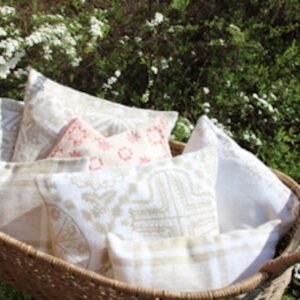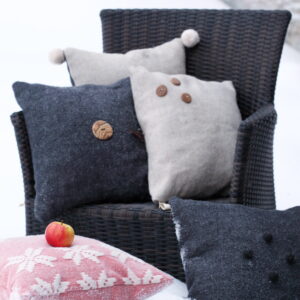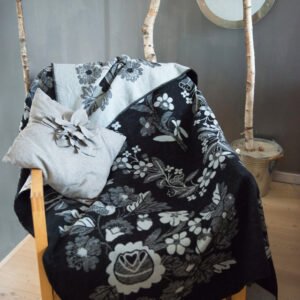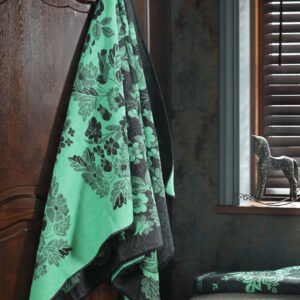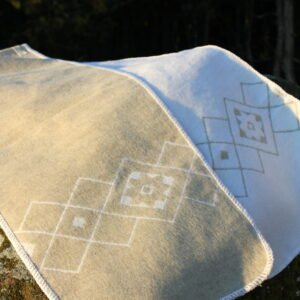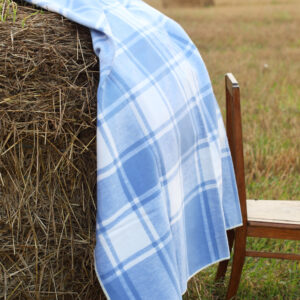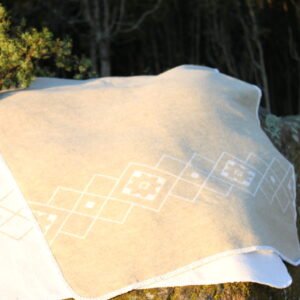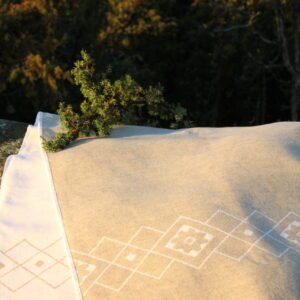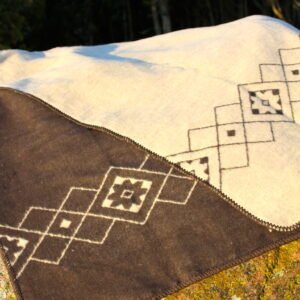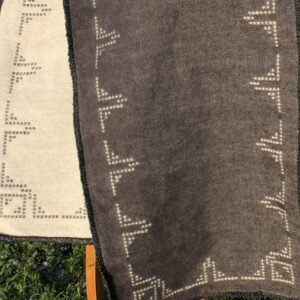+ Näita rohkem
-
Paistu and Setumaa pillow-cases
-
-
-
Dimensions 70 x 200 cm In Muhu, unlike many other places, wrap and plaid were distinguished - wrap was bigger. Plaid was also being worn across one’s shoulders in this area. Embroidering of plaids was started before the I World War. These plaids were made by professional embroiderers. Embroidery of Muhu is peculiar and characteristic of the people of Muhu Island. The embroidery is divided into two major groups: geometric and plant pattern.The most typical, most used and the oldest geometric pattern motif is closed into an orderly octagon. This motif, that was called Muhu Whisk and was believed to be a sign of luck and rebirth, was often used on woollen plaids.You can see the whisk pattern motif on MUHU scarf.
-
Dimensions 140 x 200 cm 100% cotton In Muhu, unlike many other places, wrap and plaid were distinguished - wrap was bigger. Plaid was also being worn across one’s shoulders in this area. Embroidering of plaids was started before the I World War. These plaids were made by professional embroiderers. Embroidery of Muhu is peculiar and characteristic of the people of Muhu Island. The embroidery is divided into two major groups: geometric and plant pattern.The most typical, most used and the oldest geometric pattern motif is closed into an orderly octagon. This motif, that was called Muhu Whisk and was believed to be a sign of luck and rebirth, was often used on woollen plaids.You can see the whisk pattern motif on MUHU scarf.
-
-
Dimensions 35 x 180 cm 70% cotton, 30% flax Saaremaa patterns are interestingly closely related. There are similar details on coifs, sleeves and bands. Saaremaa scarf has been inspired by the band pattern of Jämaja. Band was used to fasten clothes; requisites and jewellery were attached to it. Band-making technique was well-known, young girls were already learning it. According to the technique, more common were tablet-woven band and figured belt. Tablet -woven band was long and narrow and its pattern was usually the same on both sides. I would like to thank Anita Kütt and Ulvi Põld for their help on creating the Saaremaa woollen wrap.
-
Dimensions 140 x 165 cm 100% cotton In Kihelkonna, until the mid-19th century – woollen blue and white tartan plaid persisted as a traditional shawl. Blue symbolized the sky and thinking. Checked wrap was worn across one’s shoulder. In the end of the 19th century plaids with bigger pattern were start being made. Wider plaid fabrics were start being woven and were sown together from two widths. Woven checked plaids were shrunk so that they would last several generations.
-
Dimensions 70 x 180 cm 70% cotton, 30% flax Saaremaa patterns are interestingly closely related. There are similar details on coifs, sleeves and bands. Saaremaa scarf has been inspired by the band pattern of Jämaja. Band was used to fasten clothes; requisites and jewellery were attached to it. Band-making technique was well-known, young girls were already learning it. According to the technique, more common were tablet-woven band and figured belt. Tablet -woven band was long and narrow and its pattern was usually the same on both sides. I would like to thank Anita Kütt and Ulvi Põld for their help on creating the Saaremaa woollen wrap.
-
Dimensions 105 x 180 cm 70% cotton, 30% flax Saaremaa patterns are interestingly closely related. There are similar details on coifs, sleeves and bands. Saaremaa scarf has been inspired by the band pattern of Jämaja. Band was used to fasten clothes; requisites and jewellery were attached to it. Band-making technique was well-known, young girls were already learning it. According to the technique, more common were tablet-woven band and figured belt. Tablet -woven band was long and narrow and its pattern was usually the same on both sides. I would like to thank Anita Kütt and Ulvi Põld for their help on creating the Saaremaa woollen wrap.
-
Dimensions 105 x 180 cm 70% cotton, 30% flax Saaremaa patterns are interestingly closely related. There are similar details on coifs, sleeves and bands. Saaremaa scarf has been inspired by the band pattern of Jämaja. Band was used to fasten clothes; requisites and jewellery were attached to it. Band-making technique was well-known, young girls were already learning it. According to the technique, more common were tablet-woven band and figured belt. Tablet -woven band was long and narrow and its pattern was usually the same on both sides. I would like to thank Anita Kütt and Ulvi Põld for their help on creating the Saaremaa woollen wrap.
-
Dimensions 35 x 180 cm 70% cotton, 30% flax Hiiumaa scarf is inspired by Pühalepa folk costumes. Pühalepa is an amazing place that also inspired the creator of the scarf, Magnus Lõppe from Hiiumaa. Shades of the shawl are taken from the oldest overall coat in Hiiumaa – long coat, sewn from sheep-brown woollen fabric. Long coat (“jäku” in Estonian) was very much loved in Hiiumaa. It was worn by both men and women.


